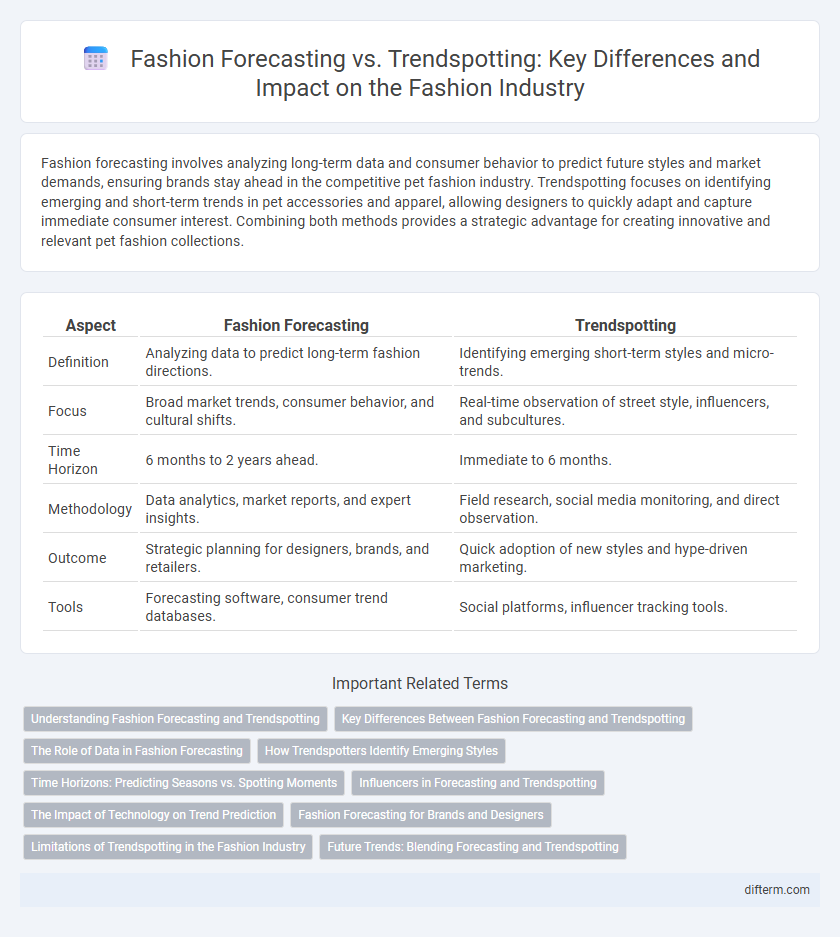Fashion forecasting involves analyzing long-term data and consumer behavior to predict future styles and market demands, ensuring brands stay ahead in the competitive pet fashion industry. Trendspotting focuses on identifying emerging and short-term trends in pet accessories and apparel, allowing designers to quickly adapt and capture immediate consumer interest. Combining both methods provides a strategic advantage for creating innovative and relevant pet fashion collections.
Table of Comparison
| Aspect | Fashion Forecasting | Trendspotting |
|---|---|---|
| Definition | Analyzing data to predict long-term fashion directions. | Identifying emerging short-term styles and micro-trends. |
| Focus | Broad market trends, consumer behavior, and cultural shifts. | Real-time observation of street style, influencers, and subcultures. |
| Time Horizon | 6 months to 2 years ahead. | Immediate to 6 months. |
| Methodology | Data analytics, market reports, and expert insights. | Field research, social media monitoring, and direct observation. |
| Outcome | Strategic planning for designers, brands, and retailers. | Quick adoption of new styles and hype-driven marketing. |
| Tools | Forecasting software, consumer trend databases. | Social platforms, influencer tracking tools. |
Understanding Fashion Forecasting and Trendspotting
Fashion forecasting involves analyzing long-term consumer behavior, market data, and cultural shifts to predict future trends, while trendspotting focuses on identifying emerging styles and movements in real time. Effective understanding of fashion forecasting requires expertise in data analysis, consumer psychology, and global market dynamics, whereas trendspotting relies heavily on observation and intuition within street style and social media environments. Both practices are essential for designers, retailers, and marketers to stay ahead in the competitive fashion industry.
Key Differences Between Fashion Forecasting and Trendspotting
Fashion forecasting involves analyzing long-term market data, consumer behavior, and cultural shifts to predict future apparel styles and industry directions, while trendspotting focuses on identifying emerging, short-term trends in street style and social media. Forecasting relies on systematic research and collaboration with designers and manufacturers, whereas trendspotting is more spontaneous and driven by immediate visual cues and influencer activities. The key difference lies in forecasting's strategic, data-driven approach versus trendspotting's reactive, tactical observation of current trends.
The Role of Data in Fashion Forecasting
Fashion forecasting relies heavily on data analytics, including consumer behavior patterns, market trends, and social media insights, to predict upcoming styles and market demands accurately. Trendspotting, while more observational and intuitive, complements forecasting by identifying emerging cultural shifts and grassroots trends before they become mainstream. Incorporating big data and AI technologies enhances the precision of fashion forecasting, enabling brands to make informed design and inventory decisions.
How Trendspotters Identify Emerging Styles
Trendspotters identify emerging styles by analyzing streetwear, social media platforms, and influencer behavior to capture authentic consumer preferences in real time. They monitor micro-trends within niche communities and track the adoption rate of new fashion elements before they hit mainstream markets. This proactive approach enables early detection of shifts in color palettes, silhouettes, and fabric innovations driving upcoming seasonal collections.
Time Horizons: Predicting Seasons vs. Spotting Moments
Fashion forecasting emphasizes long-term analysis to predict seasonal trends months in advance, enabling designers and retailers to prepare collections aligned with evolving consumer preferences. Trendspotting concentrates on identifying immediate, short-lived moments that capture current cultural and social dynamics, influencing quick fashion cycles and street style. Understanding these distinct time horizons helps brands balance strategic planning with real-time relevance in a fast-paced industry.
Influencers in Forecasting and Trendspotting
Fashion forecasting involves analyzing long-term industry data and consumer behavior to predict future trends, while trendspotting focuses on identifying emerging styles through real-time observation, often influenced by social media activity. Influencers play a crucial role in both practices; in forecasting, they help shape consumer predictions by showcasing potential trends early, whereas in trendspotting, their rapid adoption and promotion of new looks provide immediate signals of shifting preferences. Leveraging influencer insights enables brands to stay ahead in designing collections that resonate with evolving market demands.
The Impact of Technology on Trend Prediction
Fashion forecasting leverages advanced algorithms and big data analytics to predict long-term industry shifts, while trendspotting utilizes real-time social media monitoring to capture immediate consumer interests. The rise of AI-powered tools and machine learning models has significantly enhanced the accuracy and speed of fashion trend predictions. Augmented reality (AR) and virtual reality (VR) technologies enable designers and brands to visualize and adapt to emerging trends more effectively, transforming the landscape of fashion innovation.
Fashion Forecasting for Brands and Designers
Fashion forecasting provides brands and designers with data-driven insights and predictive analysis of upcoming consumer preferences, fabric innovations, and color palettes, enabling strategic collection planning. Unlike trendspotting, which identifies immediate fashion shifts and viral styles, forecasting offers a long-term vision that anticipates market demand and guides sustainable product development. Leveraging AI tools and global cultural research, fashion forecasting enhances competitive advantage by aligning brand identity with future market trends.
Limitations of Trendspotting in the Fashion Industry
Trendspotting in the fashion industry often faces limitations due to its reactive nature, relying heavily on identifying emerging styles after they gain initial traction. This approach may result in delayed responses to consumer demands and a higher risk of adopting fleeting fads rather than sustainable trends. Unlike fashion forecasting, which uses data analysis and market research to anticipate long-term shifts, trendspotting can lack predictive accuracy and strategic depth.
Future Trends: Blending Forecasting and Trendspotting
Fashion forecasting leverages data analytics, consumer behavior, and cultural insights to predict long-term industry shifts, while trendspotting focuses on identifying emerging styles and street-level influences in real-time. Blending forecasting with trendspotting enables designers and brands to anticipate future trends more accurately by combining macroeconomic patterns with grassroots creativity. This integrated approach enhances strategic decision-making, ensuring collections resonate with evolving consumer preferences and market demands.
Fashion forecasting vs Trendspotting Infographic

 difterm.com
difterm.com